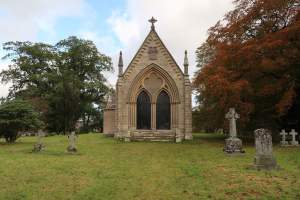In the Duff House Mausoleum, just inside the door, is one list of who is buried in the crypt. One of these is Arthur Duff of Orton.
He was the youngest son of the 1st Earl Fife who often referred to him as “my little Attie”; he was clearly a favourite of his parents and throughout his life much loved by all the family.
As his elder brother, James the 2nd Earl Fife, and Arthur himself, were both Members of Parliament at the same time (1774 to 1779) there was a falling out over some policy issues, but although this upset caused them to even pass each other in the street without acknowledging each other, it all seemed to get sorted out over the years.
Arthur, born 1743, spent his childhood at Rothiemay House – where his parents lived even though Duff House was being built at the time. He went to university in St Andrews and Glasgow, but also in Leiden, Holland – one of the leading universities of the time.
After his spell as a MP living in London, at which the Parliament records show he was extremely diligent, but not a great speaker, he came back to Scotland in 1779. With his family’s connections, he was appointed Comptroller – effectively Chief Accountant – of the Scottish Excise. He lived at Rothiemay House until his mother died in 1788, and then moved to Orton House.

Orton House circa 1900

Orton House after refurbishment
Arthur was a very keen letter writer, many of which still survive; at times he was writing every day particularly to his mother. He also seems to have been the family member that kept in touch with his brothers and sisters, keeping all of them informed of how each of them was doing. From other letters it seems he was the favourite uncle of many of the extended family. It is not surprising therefore that he should sit on a committee in Elgin, trying to get the mail service north of Edinburgh to be working better; regular daily mail coaches didn’t start running to Inverness until into the 19th century. Arthur and other members of the gentry were keen “of obtaining the most speedy and effectual remedy to an evil so injurious to the commerce of the country and inconvenient to private correspondence”; the meeting reports that mail travels at an average of 5 mph from Edinburgh to Aberdeen, and only 2 mph Aberdeen to Inverness! In 1790 the average letter from Banff sent on a Monday would only arrive in Edinburgh on Friday.
Apart from this he was as helpful as he could be to the local community. He looked after those living on his estate, he paid for the education of some, donated to road building, including the original Spey Bridge near Fochabers.

Arthur Duff of Orton (1743 – 1805) by George Watson
Arthur, never married, died on 2nd June 1805 but his memory carries on. His nephew, Richard Wharton-Duff, built two structures “to preserve for ever on his property the memory of a man universally respected and beloved”. The younger Arthur wrote “In him the prefix to his name [The Honourable] was not a mere title of courtesy; for his high and unbending principles of rectitude, the warmth and sincerity of his friendships, and the true benevolence of his heart, which so justly endeared him to all – eminently merited the distinguished epithet in its fullest sense.”

St Mary’s Chapel, Orton Estate
The first was a chapel, built 1844, now St Mary’s (named after the earlier Norman church that had become ruinous) and is now a private family Mausoleum for the Wharton-Duff family. There is a stone within the chapel confirming the dedication to the memory of The Honourable Arthur Duff of Orton.

Arthur’s Bridge – courtesy of the Ordnance Survey
The second was built in 1852, built of wood from Larch trees planted by Arthur, as a bridge across the River Lossie southeast of Lossiemouth. In 1884 the bridge was replaced by a bailey bridge with steel plates, but that in turn was replaced by the present B9103 road bridge in 1970. On Ordnance Maps it is still named as “Arthur’s Bridge”.
Orton House has now been refurbished and is part of the sporting and holiday Orton Estate, still owned by the descendants of the Wharton-Duff family.

